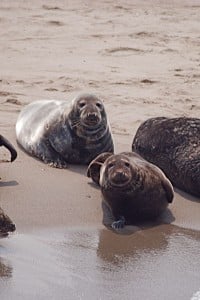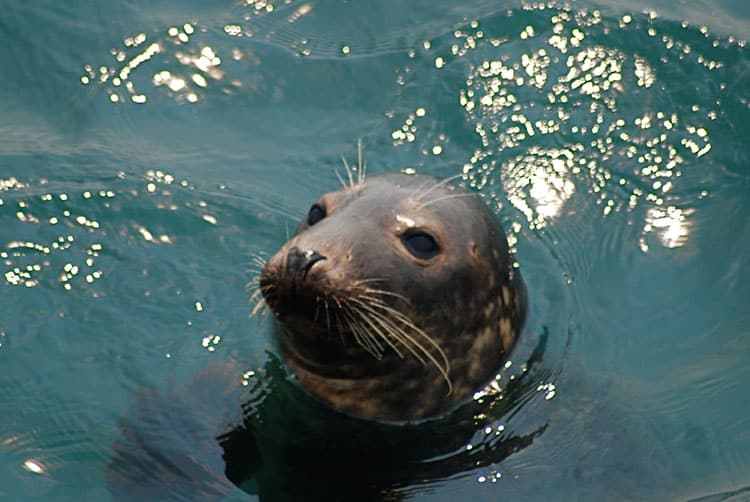• by Sarah Teach •

A Bounty for Every Nose
From colonial times until the mid-20th century, Cape Codders legally killed gray seals in droves for the five-dollar bounty placed on seal noses by the Massachusetts government. By the 1950s, the species’ numbers had dropped tremendously, and gray seal sightings were an extreme rarity on Nantucket. In 1962, Massachusetts banned the killing of seals; 10 years later the U.S. government followed suit with the Marine Mammal Protection Act (MMPA). The 1972 law makes it a federal crime to kill, harass or disturb a marine mammal in a way that changes its behavior. The law states that marine mammals “should be protected and encouraged to develop to the greatest extent feasible commensurate with sound policies of resource management and that the primary objective of their management should be to maintain the health and stability of the marine ecosystem.”
Almost 20 years after Congress passed the MMPA, there were still only six gray seal pups counted on Muskeget, a tiny island that lies about three miles northwest of Nantucket, shore to shore. It took until 2002 for the seals’ numbers to reach 1,000; but with the protection afforded them by the MMPA, their population continues to thrive. By 2008, more than 2,000 pups were born on Muskeget; and today, Muskeget is the largest gray seal pupping colony in the United States. Marine mammal preservationists are rejoicing as they witness a species return from the brink of local extinction. Some local fishermen, however, are concerned about the number of fish that seals snatch from their lines. The fishermen are also forced to find new fishing spots if seals are resting on the beaches where they intend to fish. We are decades removed from the days of seal hunting, but 1,500 Cape and Nantucket residents are lobbying for the abatement of the seals. Marine mammal preservationists are lobbying just as hard.
Who’s In The Ring?
The Nantucket Marine Mammal Conservation Program (NMMCP) was founded in 1977 by Jean Rioux, an island resident who had become concerned for the well-being of marine mammals in Nantucket waters. Today, the NMMCP continues to operate under the leadership of island residents Scott Leonard and Michelle Perkins. On the other side of the ring is the Seal Abatement Coalition (SAC), a not-for-profit corporation self-described as “a group of individuals and organizations that believes that the rapid expansion of the gray seal population poses a danger to the recreational and commercial uses of the Cape and Islands’ inshore waters.” The SAC president Peter Krogh says the group is diverse in composition, and its views on what should be done about the gray seal population are equally as diverse. The most common question posed to the SAC is ‘What should be done?’ In a statement to the community, Krogh said, “Our answer is that we do not know.” A SAC spokesperson, Peter Howell, assured islanders, “Lest there be any doubt, we do not advocate a return to hunting, culling, or physical harm to seals.” Still, many people who lend an ear to some local fishermen know that Howell does not speak for all of SAC’s supporters.
It’s not surprising that NMMCP and SAC have butted heads over the past few years. In an effort to understand both sides’ intentions and find some common ground, the Nantucket Civic League hosted a well-attended panel discussion on May 20, entitled “Seals, Humans: Finding a Balance.” Civic League Vice President Dr. Sarah Oktay moderated the evening’s conversation between representatives from both groups. On the NMMCP’s side was Dr. Solange Brault, seal researcher and Associate Professor of Biology at the University of MA, Boston; attorney Michael Jasny, Director of the Marine Mammal Protection Project and a Senior Policy Analyst at the Natural Resources Defense Council; and Sharon Young, Marine Issues Field Director for the Humane Society of the United States. The SAC panelists included Captain Tom Mleczko, a long-time island resident who owns a local fishing charter; along with Howell and Krogh, both of whom are recreational fishermen and year-round residents of Nantucket.
An Open Conversation
Krogh began the SAC’s speaking slot by stating the group’s perspective: “We believe the exploding gray seal population poses both real and potential threats to recreational and commercial fishing; to beach-goers, swimmers, and surfers, to the economy, to the environment, and to public health and safety. At the same time, not enough is known about these real and potential impacts. Accordingly, the SAC pursues a track that encourages and facilitates research in these areas.” He continued, “While the SAC supports research, it also believes that there is a time urgency to the needed research.”
Dr. Brault answered by sharing some of research she has been working on for the past few years: a population growth diagram suggesting that gray seals are not yet at carrying capacity (the maximum population of a particular species that its habitat can sustain), but that their rate of growth has actually been slowing over the past several years. “There has been an increase in the decrease,” she pointed out with a chuckle. “Their numbers are not increasing as quickly as they could be.”
Howell responded by posing a question about optimum sustainable population, referencing a stipulation in the Marine Mammal Protection Act. “How do we determine success in the context of the MMPA? When does success tip over into excess?”
To this, Young responded, “Optimum sustainable population … is a formula based on maximum productivity approaching carrying capacity.” She said that once a species reaches a number that the environment will comfortably sustain, there is a leveling off of growth, and eventually, even decline. Dr. Brault added that much of the seal population around Nantucket consists of “immigrant seals” from Canada; thus, localized abatement measures would be futile, as seals would keep coming in from the North.
Who Owns the Fish?
Next, Captain Tom Mleczko took the helm, relaying his current fishing situation as it relates to the increased presence of seals. Instead of the glory days of a 10-15 minute commute from the dock to casting, he and his clients now must travel about an hour or an hour-and-a-half until fishing commences. He said, “Fishing’s still good; there’s just less fishing time, more travel time.” He discussed his quests for bluefish on the south shore over the last few years: “It’s a terrific fishery,” said Mleczko. “But … we’ve had some evidence of seals. We actually had a local seal follow us, hiding out under the boat, taking [fish] off the lines. It’s certainly changed our business [and] made it more difficult.” He added, “I think the seals have virtually shut out the fishing on the west end of the island.” Mleczko also mentioned that now he must give a safety warning to his strikers when they are fishing. Instead of being able to pull up a line without a worry, now they must first check their line to be sure a snapping seal isn’t staring them down from the other end. “This is, again, recreational fishing,” he added. Krogh too commented on the economic impact of depleted fishing on the island: “People aren’t going to spend the kind of money that it takes to come over here if they’re going to have their fish stripped from them.” When an audience member asked, “Who owns the fish?” a chuckle rippled through the room. Moderator Sarah Oktay noted the philosophical value of the question, and repeated it.
Outside of the forum, Yesterday’s Island reached Blair Perkins, owner and operator of Shearwater Excursions, a Nantucket-based ecotourism charter. Perkins addressed the complaint of many fishing charter boats: “A lot of the boats … like to give a show to their clients by feeding seals right off their boats. So [following boats for food] became a learned behavior of those seals. That has created a lot of problems, especially out at GP,” said Perkins, using the mariner’s term for Great Point, the northernmost tip of Nantucket. During a recent Board of Selectmen meeting, Perkins stated that ecotourism is one of the fastest growing industries in the country. He emphasized the ethical requirement that humans share the earth and water with other species that live here. “Seals are not an introduced species like deer and the gray squirrel,” said Perkins. “They’ve been here a lot longer than we humans have, and now, they’re just reestablishing their habitat. They’re part of the natural ecosystem here.”
Between Humans and the Deep Blue Sea
Young rebutted one of the SAC’s concerns—seal-related water quality problems—with recent research by the Northwest Atlantic Seal Research Consortium and the Woods Hole Oceanographic Institution to back her up. Their nine-year study, which was published in December 2012, examined 89 sites around the Cape where seals “haul out,” or come to shore in order to socialize and rest. Sites being tested as haul-out locations were considered to be those within five miles of seal haul-outs. The WHOI report states, “This distance was chosen to represent what we thought would be a reasonable distance for the dispersion and inactivation of [the harmful bacterium being sought] on a daily tidal schedule.” The study ultimately found that the water quality near seal haul-out locations is actually better than the water quality near humans, who incidentally, do the same sorts of activities on the beach. Yesterday’s Island reached Dr. Sarah Oktay for comment, and she explained the phenomenon simply: “Seals eat the fish here, and poop out the fish here. Humans eat the steak from Texas, and then poop out that carbon and nitrogen and phosphorus in Massachusetts.”
But even beachgoers who are not concerned with fishing or water quality cannot escape the big, bad wolf of this conversation: great white sharks. Dr. Greg Skomal, a marine biologist who specializes in shark research for the Massachusetts Division of Marine Fisheries, believes that the growing seal population is drawing white sharks closer to shore as seals are the sharks’ primary prey. Krogh said, “The greatest generator of signatures on [the petition supporting SAC’s mission] here on the island has been at Force Five, a chandlery for the surfers. The intimidation factor is very real for beachgoers, surfers and swimmers.” New Englanders won’t soon forget the well-publicized encounter between a white shark and a swimmer in Truro on Cape Cod last summer, or the shark attack on a seal at Great Point last fall. Of course, people are advised to avoid swimming when seals are visible in the water. But the SAC is still concerned about a possible downturn in tourism to Nantucket, and the consequent economic cost to the island.
What Is Being Done?
At the close of the discussion on May 20, an exasperated Howell said, “I just wonder if we have any kind of agreement or consensus here.” Jasny implored Howell and the SAC to find a solution that is within the confines of the current law, without seeking amendments. The SAC remains committed to calling for further research and has presented to the Board of Selectmen a referendum which, if adopted exactly as proposed, would have the gray seal population deemed “a public nuisance.” This nomenclature may have far-reaching consequences, as the Marine Mammal Protection Act does allow room for mitigation of “nuisance animals.” The full referendum can be found at www.nantucket-ma.gov under the 5/22/2013 Board of Selectmen Meeting Agenda Packet, beginning on page 13. What happens next depends on how the Nantucket Board of Selectmen handle the referendum that was presented to them. As we go to press on this issue, they are still considering the best course of action.
For additional information and research, visit:
www.nantucketmarinemammals.org
www.nmfs.noaa.gov/pr/pdfs/laws/mmpa.pdf
www.npr.org/templates/story/story.php?storyId=129180179
www.sealabatement.com
www.whoi.edu/news-release/Gray-Seals-Water_Quality
www.nantucket-ma.gov
www.nefsc.noaa.gov/nefsc/publications/tm/tm219/184_GRSE.pdf
www.nantucket-ma.gov/Pages/NantucketMA_BOS/index



